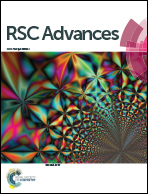Studies on the electrodeposition and characterization of PTFE polymer inclusion in Ni–W–BN nanocomposite coatings for industrial applications
Abstract
A Ni–W–BN–PTFE nanocomposite coating with excellent corrosion and friction resistance alongside hardness and a smooth surface was developed. This was achieved by introducing polytetrafluoroethylene (PTFE) polymer to an optimized Ni–W–BN nanocomposite coating deposited on a mild steel substrate by direct current (DC) and pulse current (PC) methods. The deposition was characterized using field-emission scanning electron microscopy (FE-SEM), energy dispersive X-ray analysis (EDAX) and X-ray diffractometry (XRD). The microhardness and friction resistance of the coatings were measured by using a Vicker’s microhardness tester and a TR-101-M4 scratch tester. The contact angle (CA) of a water droplet on the surface of the nanocomposite coating was measured by optical contact goniometry (OCA 35). The corrosion behaviour was measured using Tafel polarization and impedance methods in 3.5% NaCl solution. It was observed that the co-deposition of PTFE solid lubricant particles on the Ni–W–BN nanocomposite coating resulted in a comparatively smooth surface, higher microhardness, a lower friction coefficient, excellent water repellency and enhanced corrosion resistance. The PC method showed enhanced performance over the DC coating due to uniform and smaller grain deposits.


 Please wait while we load your content...
Please wait while we load your content...